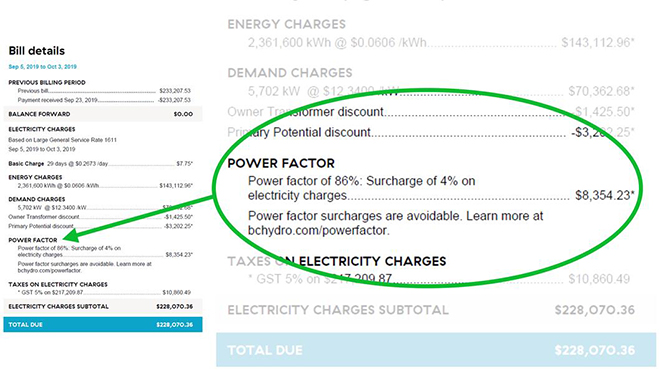Your power factor - what it is and how to reduce it

Understand this line item and how it affects your bill
Back in August, we took a look at the demand charges on your BC Hydro bill. We explored how to control them and saw what a big difference this can to your bill without any infrastructure upgrades. Now we're going to take a look at the line item that appears under your demand charge: your power factor.
What is your power factor?
The power that your electrical system uses is split into two types:
- Real power (measured in kW) is the electricity your system uses to run your equipment and perform useful work
- Reactive power (measured in kVAr) is the additional electricity your system needs to run electronic items and anything that produces a magnetic field (such as a motor)
- Both of these together are known as Apparent power (Real power plus Reactive power)
The more Reactive power your system needs, the less efficiently it performs. This causes inefficiencies in our electricity transmission system such as energy losses, voltage fluctuations and power quality issues for neighbouring facilities, negatively affecting their equipment. It also limits our capacity to deliver energy to you and our other customers. The higher these inefficiencies are, the higher your power factor surcharge.
Your power factor is displayed on your bill as a percentage. It's the result of a calculation made between your Real power and your Apparent power.

A 100% power factor is excellent. The energy charges on your bill are for the Real power you've used. A surcharge is based on a percentage of the total of all other charges on your bill. This is applied when your power factor drops below 90%. The lower your power factor percentage is, the more you pay — the table below shows how this can rapidly add up. For example, if your power factor is 87%, you'll pay a surcharge of 4% on your electricity usage. But if your power factor drops to 77%, your surcharge is 16%.
| Power factor | Surcharge |
|---|---|
| 90 - 100% | None |
| 88 - 90% | 2% |
| 85 - 88% | 4% |
| 80 - 85% | 9% |
| 75 - 80% | 16% |
| 70 - 75% | 24% |
| 65 - 70% | 34% |
| 60 - 65% | 44% |
| 55 - 60% | 57% |
| 50 - 55% | 72% |
| 0 - 50% | 80% |
What can cause a lower power factor?
Large inductive loads such as power transformers and electric motor-driven loads, like fans, pumps and air compressors are common causes of low power factors. Other causes can include older variable speed drives, compact fluorescent lighting, electrical chargers and induction furnaces.
Here are some of the first things you should check:
- Large fans and motors (especially if they are only partially loaded)
- Equipment with a high number of transformers (such as lighting ballasts)
- Failed or improperly sized capacitors (used for power factor correction)
- Harmonics in a system caused by non-linear electrical loads
How to improve your power factor
A qualified electrical contractor can provide power factor correction services and/or equipment. Maybe you’ve got an electrician on staff or one you already work with who can do this for you. If not, we can also provide referrals through our Alliance of Energy Professionals, which includes qualified contractors that can help you optimize your power factor.
As well as reducing your bill, there are several other benefits to improving your power factor:
- Enhancing your equipment operation by improving voltage
- Improving your energy efficiency of your electrical system by reducing line losses
- Eliminating or reducing transformer maintenance or upgrades
- Restoring the kVA capacity of your electrical distribution system
Find out more about power factors and general service business rates - and if you have any other questions, you can always contact your Key Account Manager or the BC Hydro Business Helpdesk:
- industrial@bchydro.com
- 604 522 4713 (Lower Mainland)
- 1 866 522 4713 (Elsewhere in B.C.)